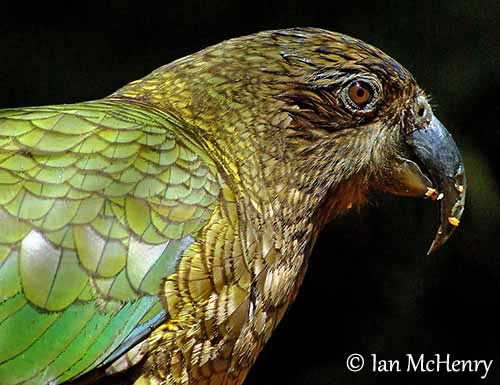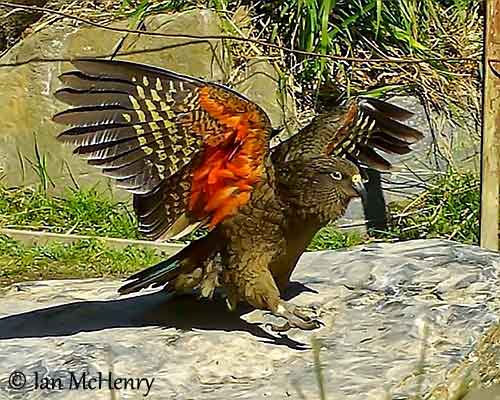
Text by Nicole Bouglouan
Photographers:
Ian McHenry
My New Zealand Birds
Dianne Mason,
Alastair Morrison,
Don Merton,
Courtesy of Department of Conservation Te Papa Atawhai, 2014
Department of Conservation
Sources:
PARROTS OF THE WORLD – An Identification Guide – by Joseph M. Forshaw – Princeton University Press – ISBN 0691092516
KNOW YOUR NEW ZEALAND BIRDS by Lynnette Moon - New Holland Publishers – ISBN: 1869660897
BirdLife International (BirdLife International)
CREAGUS@Monterey Bay (Don Roberson)
Wikipedia (Wikipedia, The Free Encyclopedia)
STRIGOPIDAE FAMILY
New Zealand Parrots
Kea, New Zealand Kaka, Kakapo
The Family Strigopidae includes three New Zealand endemic species, with only two genera, “nestor” and “strigops”.
These parrots are unique in appearance and their behaviour is often different from that of other Psittaciformes. Unlike other parrot species, they do not mate for life. The Kea is polygamous and the males may have up to four mates whereas the Kakapo does not form pair-bonds and uses a “lek” breeding system.
The three species are confined to New Zealand and several offshore islands. They were formerly widespread, but their populations were affected by introduced mammalian predators, hunting, habitat loss and illegal pet trade, the latter at least for the Kea. The Kakapo was led almost to extinction by cats, rats and stoats.
These species are now living in protected areas, reserves or national parks and predator-free offshore islands. Their small populations appear today more stable or slowly increasing, but they have restricted range and the numbers are still low.
They are protected by several conservation measures and the efforts of the Department of Conservation allow some good hope for a slow recovery of the populations.
Kea, New Zealand Kaka and Kakapo are stunning birds. They are part of New Zealand, their native country.

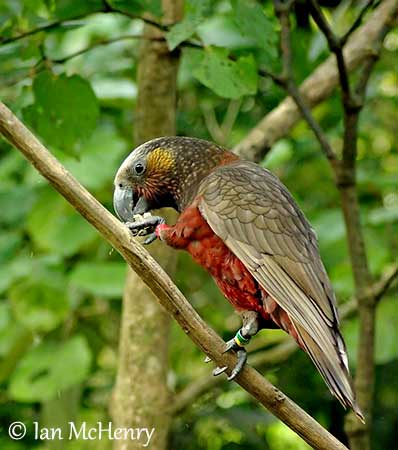

One of the Kakapo chicks from the 2008 brood, Codfish Island, July 2008
The Kea and the New Zealand Kaka are large, stout parrots with strong and heavily hooked bill.
The Kea has olive-green plumage with conspicuous orange underwings and rump. The tail is broad and square. The female has shorter bill and the juvenile has yellow cere and eyering instead of grey.
The New Zealand Kaka has brown and red plumage and whitish crown. However the subspecies N.m. septentrionalis is duller with pale grey crown. The bill is massive with elongated upper mandible. The female has browner face and shorter bill. The juvenile has paler eyering.
The Kakapo is the largest parrot. The broad, rounded wings are rudimentary and the bird is flightless. Its plumage is green with yellow and brownish mottling, and yellower pattern on the underparts. It has distinctive flat, owl-like face with conspicuous facial disk and rictal-bristles around the bill base. The female is smaller than the male, and the juvenile resembles adults with pale brownish face and underparts. They are nocturnal.
Both Kea and New Zealand Kaka feed on seeds, fruits, nectar, insects and their larvae, but the Kea regularly scavenges at rubbish dumps. The Kakapo is vegetarian and feeds exclusively on a variety of plant matter.
They feed on the ground and in trees, often in groups, although the Kakapo is more solitary. This terrestrial bird climbs branches and trees and may glide over short distance from the tree to the ground. Unlike the Kakapo, the “nestor” species are powerful fliers. During the flight, the red underwings are conspicuous.
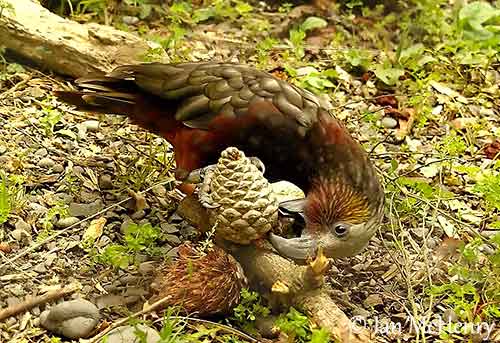
They frequent dense forest, even high in mountains for the Kea which can be seen from the lower valleys to the steep mountains. This species occurs in the mountains of South Island.
The New Zealand Kaka frequents the forests with mature trees, and occurs from 450 to 1000 metres of elevation. The two subspecies share the New Zealand range, including large offshore islands.
The Kakapo is now living on forested islands but formerly, it was present from Podocarp forest in lowland, to Notophagus in upland beech forest and subalpine scrublands in New Zealand. Now, this species survives in predator-free offshore islands.
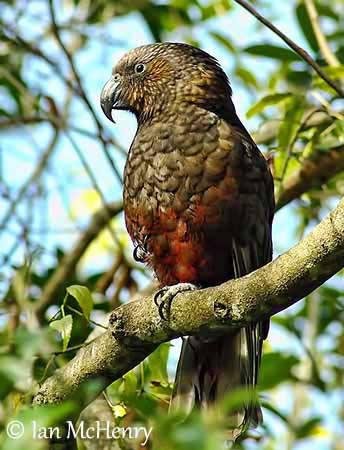
N.m. septentrionalis
The Strigopidae can be noisy, like all Psittaciformes. The Kea gives far-carrying “keee-aah” in flight, while soaring high in the air. On the ground, they communicate by soft sounds and whistles.
The New Zealand Kaka also calls in flight, giving harsh, grating “kraa-aa” and other sounds including a variety of yodelling notes.
The Kakapo has unique voice among parrots. The male produces low-frequency, far-carrying booming while displaying at lek. It lowers its head and inflates the thoracic air-sacs in order to produce descending grunts leading to loud booming calls. Some other strange sounds can be heard too.

Kakapo chick 2009
Their breeding behaviour differs from each other. The Kea is polygamous. The males fight for hierarchy and dominance. These hierarchies are not linear. An adult male may dominate a subadult, but a juvenile male may be dominant to an adult male. They nest under rocks or logs, or in cavities among boulders or tree roots. The female lays 2-4 eggs in the nest made with sticks, grasses and moss, between July and January. Both parents raise the chicks.

Juvenile on the left
The New Zealand Kaka performs some displays which enhance the bright red underwings. This species nests in cavities in mature trees, lined with powdery wood dust. The 3-4 eggs are laid between September and March. The male feeds the female during the incubation, and then, both parents raise the chicks.
The Kakapo has unique breeding behaviour and uses a “lek” system. It creates shallow depressions in the earth, and may have up to 10 bowls from which it attracts females with deep, booming calls. The female enter a bowl and choose a male. However, no pair-bond is established. The male does not take part in nesting duties. The female forms a scrape in a hollow protected by log or under tussock. She lays 2-3 eggs and raises the chicks alone between November and February.
The Strigopidae move according to the food resources but they are sedentary in their range. The Kakapo may walk over several kilometres by night. Kea and New Zealand Kaka sometimes perform altitudinal movements after breeding. The juveniles may wander after the breeding season.
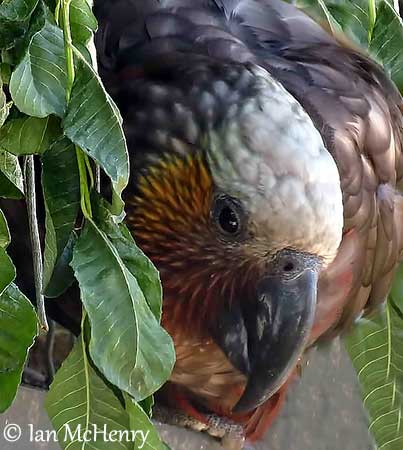
The three species have small populations, due to introduced mammalian predators such as cats, rats and stoats. Forest clearance and degradation of the habitat affected these species which live in forest and dense vegetation, like hunting and sometimes pet trade in the past. In addition, they are living in restricted range.
The Kea’s population is estimated at about 3,300 mature birds and decreasing. The species is listed as Vulnerable.
The New Zealand Kaka’s population is around 1,500/7,000 individuals. It is classified as Endangered.
The Kakapo’s population is very small with 126 individuals including 78 breeding adults. The species is Critically Endangered.

Ros Cole (in DOC uniform) holding the 82 day old male Kakapo "Tiwai"
Codfish Island, June 1997
Several conservation measures managed by the Department of Conservation, allowed some slow increase of these small populations. The birds have been translocated and introduced to offshore predator-free islands where they can breed and raise their chicks safely. In the same way, the remaining forests are protected, and the islands where the birds are now established are forested too.
Good luck for the recovery!
